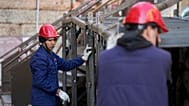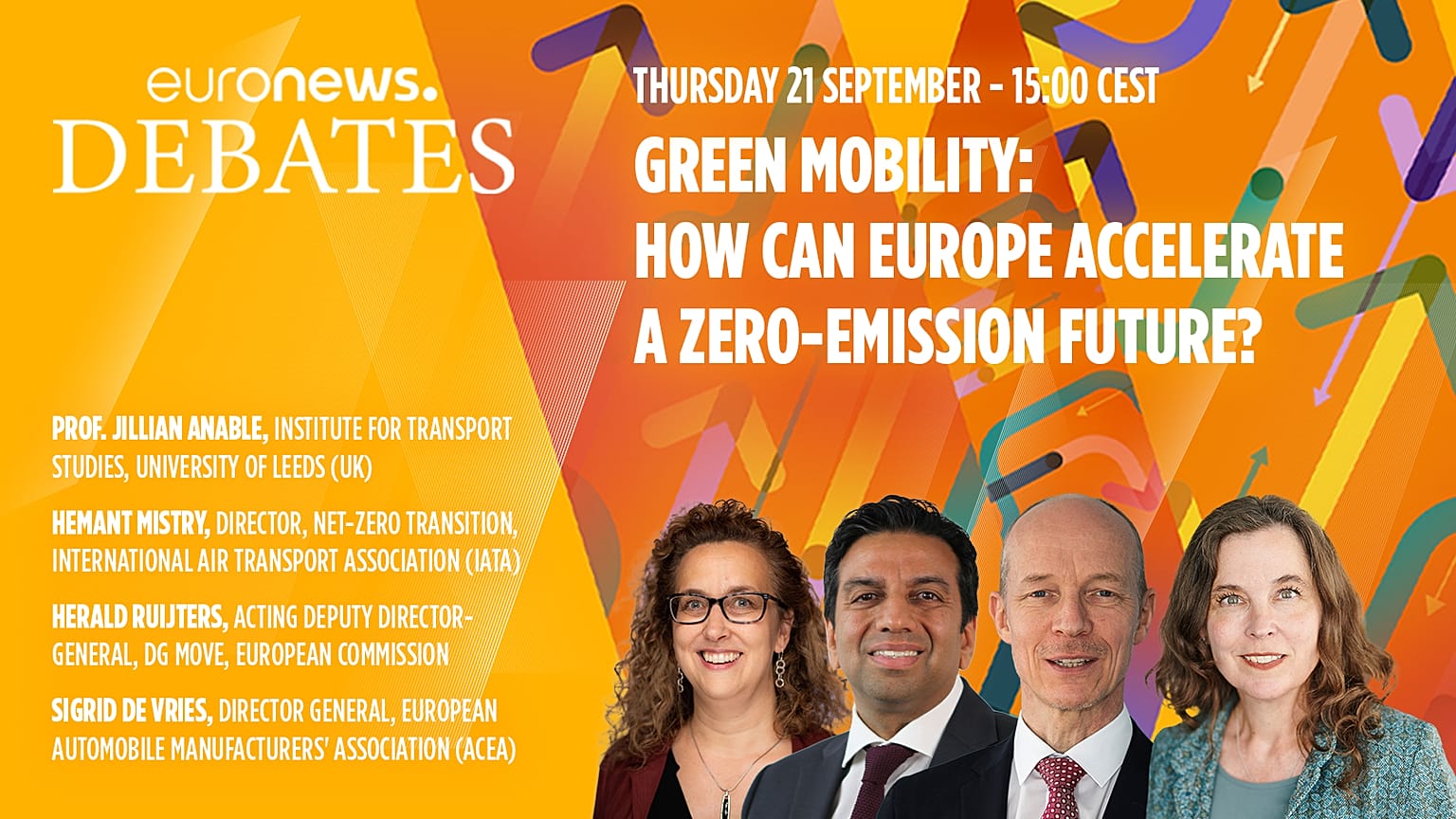For our latest Euronews Debate, we’ve been discussing the future of mobility in Europe and the push to make a swifter transition to greener alternatives.
Transport is the lifeblood of our society, powering economies and keeping us all on the move. But faced with a rapidly warming planet and big questions over the future of energy, Europe is under mounting pressure to accelerate its transition to cleaner and greener mobility.
How can this be achieved?
Watch our latest Euronews virtual debate: "Green Mobility: How can Europe accelerate a zero-emission future?"
Here's a look at the panellists who joined us:
Herald Ruijters, Acting Deputy Director-General, DG Move, European Commission
Herald Ruijters is responsible for Investment, Innovative & Sustainable Transport in DG Mobility and Transport. His main responsibilities are the funding instruments Connecting Europe Facility and Horizon Europe and the financing instrument InvestEU.
Herald also assumes responsibility for the development of the trans-European transport network, the urban mobility framework, alternative fuels infrastructure, intelligent transport systems, as well as passenger rights, social aspects and equal opportunities.
Hemant Mistry, Director, Net-Zero Transition, International Air Transport Association (IATA)
Hemant Mistry has 30 years’ experience in aviation, including technology application, commercial strategy and regulatory reform. He leads IATA’s energy transition activities to support decarbonisation of the industry, working across airlines, governments and the supply chain to achieve Net Zero by 2050.
During the COVID-19 pandemic, Hemant was responsible for IATA’s work on securing financial support for airlines and supply chain partners. Prior to this, Hemant was IATA’s Director of Infrastructure and Fuel.
Sigrid de Vries, Director General, European Automobile Manufacturers’ Association (ACEA)
Sigrid de Vries has longstanding experience working for strategic EU industry sectors, from automotive manufacturers to suppliers, to the construction equipment sector. She has held various external affairs and leadership roles and has a strong track record in representing industries in times of fast-paced transformation.
Prior to her current appointment at ACEA, Sigrid de Vries was Secretary General of the European Association of Automotive Suppliers (CLEPA).
Jillian Anable, Professor of Transport and Energy, Institute for Transport Studies, University of Leeds (UK)
Jillian Anable is Professor of Transport and Energy at the Institute for Transport Studies, University of Leeds, in the UK. Her research addresses the potential for demand-side solutions to reduce carbon and energy from transport.
Broadly, her current research direction investigates “the future of the car” – bringing together socio-technical developments including electrification, new mobility services and the psychology of car owning and driving, to explore the concept of “car usership”.
Fossil fuels still the norm
Moving people and goods around comes at a huge cost to the environment, contributing around one-quarter of the EU’s total greenhouse gas emissions. The costs of congestion to society are put at €270 billion a year.
“Still, even today, between 95 and 100 per cent of all movements that are done in motorised vehicles globally are still powered by fossil fuels, and it’s the combustion of fossil fuels that creates most of the nasties,” Professor Jillian Anable said, setting up the stark context for the debate.
“The one we hear about a lot is carbon emissions. These emissions contribute to climate warming and the sector, as a whole, is responsible for between a fifth and a quarter of global carbon emissions,” Anable said.
“Even if we got rid of all the fossil fuels out of the system, we’ve got issues around how we find all the materials for all the vehicles, tyres, where we get enough land for roads and parking and so on.”
Going green is ‘not going to be easy’
At an EU policy level, mobility is a big part of the European Commission’s drive to help save our planet. It’s been aligning urban mobility regulations with the goals of its flagship Green Deal.
“We have been launching legislation for decarbonising transport. The different ones to abate, like the maritime and aviation sector, but also all the others. We want to be sure that by 2050, we are at net zero for those emissions. It’s not going to be easy,” said Herald Ruijters, from the European Commission.
“But I would like to stress, transport may be seen as a problem, but it’s also a solution because it means connectivity. It also means our economy can flourish.”
Targets take ‘our eye off the ball’
While acknowledging that targets are important, Anable issued a warning about having an obsession with them.
“What really matters for the carbon emissions is the average CO2 of the fleet. If we continue to sell lots of gas-guzzling cars between now and whenever the target date is, 2030 or 2035, those cars are going to be on our roads into the 2040s and when you do the modelling, that’s more important than the target date itself,” she explained.
“It’s allowed us to take our eye off the ball of the metrics and the things that are really important, with regards to the total amount of CO2 we’re going to produce between now and any target date.”
‘Massive transformation’ for car industry
By 2030, the European Commission wants to see at least 30 million emission-free cars on the roads. Progress is already being made, with an increasing - but limited - take-up of electric vehicles (EVs).
Sigrid de Vries, from the European Automobile Manufacturers’ Association (ACEA), said the auto industry is undergoing a “massive transformation” right now, highlighting that the EU is the only region in the world that has a 100 per cent CO2 reduction target for cars, taking effect in 2035.
“That in turn means a complete overhaul of the manufacturing facilities. Going to batteries instead of engines, we need new supply chains, you need entirely new skills for those employed by the industry,” she said.
“That also means a huge shift in how we’re using our cars. We need to charge them, we need charging spots, we need the electricity grid to be up for this, and we also need the electricity to be green. We have in place the regulatory framework, but what we are missing is a clear business case not only for industry but also society. We need to scale up.”
Making road transport greener isn’t all about going electric, with no shortage of other alternatives being developed.
The likes of Renault, for example, have released a hydrogen-power utility vehicle and unveiled concept cars. Autonomous vehicles could also have a crucial role to play in Europe’s sustainable future.
Will alternative fuels for flying take off?
Greening up mobility also means cleaning up what happens in our skies. The aviation sector is making huge investments in new aircraft, which are more fuel-efficient. The EU expects zero-emission large aircraft to be market-ready by 2035.
Commercial airlines are also using SAF (sustainable aviation fuel) made from things like cooking oil and household waste. EU lawmakers recently approved new rules, requiring two per cent of jet fuel to be sustainable by 2025, reaching 70 per cent by 2050.
But, with passenger numbers rising back to pre-pandemic levels and airlines growing routes like there’s no tomorrow, there are big questions about whether flying can ever be truly green.
Hemant Mistry, from the International Air Transport Association (IATA), which represents airlines, stressed that there is a “very genuine will and commitment” towards making aviation cleaner and greener.
“In 2021, we were able to ensure a commitment across the membership for net-zero 2050,” he said. “There is a lot of focus on the transition to sustainable aviation fuels (SAF), which are of course the biggest lever we have towards net-zero 2050, but we’re also looking at all opportunities, including aircraft technology, improving efficiency. We’re looking at new energy solutions, hydrogen and various other aspects as well.”
How do you solve the problem of supply?
But, with SAF, there remains a big challenge around supply, with availability put at less than 0.05 per cent of total EU aviation fuel use. German airline Lufthansa reportedly fired a warning shot recently, telling automakers to keep their hands off, saying there wouldn’t be enough to go around.
“We really need to scale up because this is a major enabler,” said Mistry. “It’s really a question of how to boost production. We also need the big energy companies to ramp up in terms of SAF. We need to find solutions that are workable across the globe.”
He continued: “We need to make sure that SAF is a viable output, a commercial output, because there will be competition with other products, including renewable diesel, so we need balanced policies from governments as well.”
Tech and innovation crucial to mobility transition
New technologies and innovation are at the heart of the mobility transformation in Europe, unlocking new ways of moving people and goods around.
“We’re the biggest private investor in research and development in Europe, with over 60 billion euros each year and together, on electrification alone, over €250 billion,” said de Vries, from the ACEA, which not only represents the auto industry but also truck, bus and coach manufacturers.
“That’s more than the GDP of some member states. We are very good at innovation and technological advances, it’s also how we compete with other regions of the world. It’s not only about greening the vehicles but also making them smarter. So, it’s a digital and green transformation we’re in.”
Anable recognised the importance of tech and innovation in driving the mobility transition but highlighted the struggles of implementing it in time to make a big difference.
“In a way, it comes down to a law of nature, there is only so fast you can go,” she said. “At the moment, we have a lot of the solutions, but it doesn’t actually mean we can rely on them in time for what we need to do, for what the science tells us we need to do.”
She added: “Even if we pulled every single lever and threw a lot more money at it right now, we would still need some quite significant transitions in lifestyles. In other words, how much travelling is in the system. Because we’ve left the technological transition longer than we could have done, should have done, we’ve got to have even stronger, or deeper, changes to lifestyles".
The China issue
Amid the drive to be cleaner and greener, the race for more innovation and technology is being embraced beyond Europe’s borders.
European Commission President Ursula von der Leyen recently announced a probe into Chinese electric vehicles – something that has been denounced by the Chinese government as a “naked protectionist act.” Could a trade war be on the cards?
“The Commission has collected quite ample data and evidence from public sources and also specialised databases on the existence of quite a large range of Chinese subsidies, as well as the threat of injury to the EU industry. We are an open market but, at the same time, we need to guarantee the rules being observed,” said Ruijters from the European Commission.
“I’m not speaking about a trade war at all. I’m simply saying that the Commission has certain evidence and that the President announced that we will look into that evidence.”
Consumers ‘need consistency’
While the mobility transition relies heavily on government policy, industry action and new tech and innovation, it also falls to consumers and citizens to do their part. Changing habits and adopting new lifestyle choices.
Anable said that people “are waiting for direction” in how to act. “People want to see a level playing field where they think that if I do this thing, then I’m going to see everybody else do it,” she said.
“Individual consumers need to see consistency. They need to look out the window and think, yes I can see there’s a crisis. Not inconsistent signals and confusion.”
‘Huge’ accessibility challenge for car industry
de Vries admitted that accessibility is a “huge challenge” for the car industry.
“Cars are increasingly expensive because of materials, safety requirements, technology,” she said. “Price is a main denominator and that’s why purchasing incentives are so important and also incentives where you can park your car.”
She continued: “We see huge disparity in the EU when it comes to how electric vehicles are being taken up. It’s the more affluent countries where they go first. About 20 per cent of new cars are electric vehicles, but you see many member states where market share is below 10 per cent.”
Mitigating for the ‘most painful’
Ruijters, from the European Commission, said everyone must work “hand-in-hand” to realise the mobility transition.
“We need to take citizens with us,” he said. “There is a very important social role to this as well. We have a fund for people who would be suffering the most from this transition, the Social Climate Fund, with €86 billion that will be available for the member states to mitigate where it will be most painful.”
He concluded: “We are making the change at least in Europe, and Europe is exemplary in what it has been doing over the past five years.”















